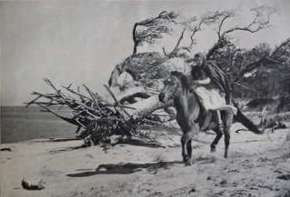British forces were moving in strength against the Patriots, intent on seizing strategic positions. The rebels were brave but seemed unaware of the forces rallying against them. The only hope was a midnight dash by horse to warn fellow countrymen of the danger. Yes, it sounds like Paul Revere, but this is actually the Outer Banks version, and this story features a young heroine named Betsy Dowdy.

It was early December of 1775 and Lord Dunmore, the Royal Governor of Virginia, had moved south from his base in Norfolk to fortify Great Bridge, the only crossing of the Elizabeth River, effectively isolating eastern North Carolina from the only port available to transport goods.
Long-time residents on the Currituck Banks, the Dowdy family received word on December 8th that Dunmore intended to move south and seize or destroy farms and livestock to prevent rebel forces from re-supplying. Not knowing how many troops the British had available, the Outer Banks residents believed rebel forces at Great Bridge were inadequate to stop Dunmore from advancing.
Late that night, after everyone had gone to bed, Betsy snuck to the stables and mounted Black Bess, her Banker horse. Under the shield of darkness, she headed to Perquimons County to bring this message to the nearest North Carolina militia at Hertford. It is a cold night and horse and rider had to wade and swim the Currituck Sound, and then ride more than 50 miles to reach the rebel militia commanded by General William Skinner. Black Bess, her genetic stock directly linked to the Spanish Mustangs of the Conquistadors, was up for the challenge and by the morning of December 9th the message was delivered.
Skinner ordered his men north, and although they are too late to join in the battle that was a resounding rebel victory, the 100 troops he brought with him convinced Dunmore that the rebel forces were too strong. The governor and his forces evacuated to ships in the harbor.
By forcing the British to retreat, the rebels denied the British the use of one of the finest harbors on the eastern Seaboard for a year. Although the British did seize Portsmouth again later in the war, the victory at Great Bridge kept northeastern North Carolina out of British hands.
Although there is substantial circumstantial proof that it occurred, the ride of Betsy Dowdy has no written records to substantiate it. There is ample evidence that word somehow reached Skinner of the British forces at Great Bridge and that the general did move his troops in response to that information. Additionally, the Dowdy family was well known on the Currituck Banks at the time, and they remain a well known influence in the county. Betsy was riding what is today considered one of the wild horses of Corolla, a breed of horse that was originally bred by the Spaniards for stamina and determination.
If the story is true, and a lot of people believe that it is, Betsy’s ride is more remarkable than Paul Revere’s ride. When Revere took his famous ride, there were two people riding together on the road to Concord and Lexington, Revere and William Dawes. Their ride, although interrupted by British soldiers, totaled 16 miles in temperate April weather, while Betsy, at the tender age of 16, and Black Bess swam the Currituck Sound and forded numerous small streams while riding 50 miles to deliver this important warning.
